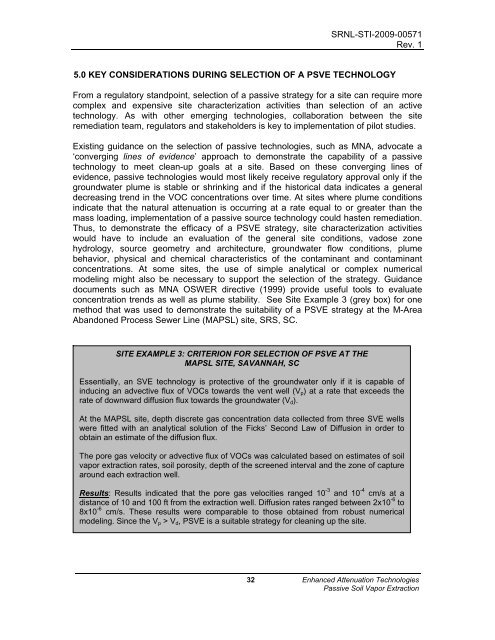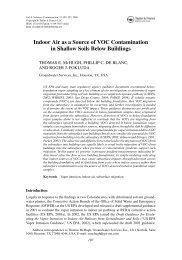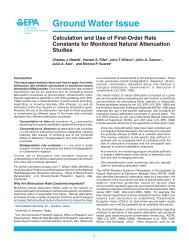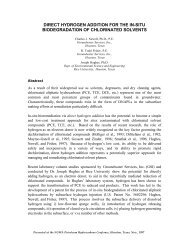Passive Soil Vapor Extraction - GSI Environmental Inc.
Passive Soil Vapor Extraction - GSI Environmental Inc.
Passive Soil Vapor Extraction - GSI Environmental Inc.
- No tags were found...
Create successful ePaper yourself
Turn your PDF publications into a flip-book with our unique Google optimized e-Paper software.
SRNL-STI-2009-00571Rev. 15.0 KEY CONSIDERATIONS DURING SELECTION OF A PSVE TECHNOLOGYFrom a regulatory standpoint, selection of a passive strategy for a site can require morecomplex and expensive site characterization activities than selection of an activetechnology. As with other emerging technologies, collaboration between the siteremediation team, regulators and stakeholders is key to implementation of pilot studies.Existing guidance on the selection of passive technologies, such as MNA, advocate a‘converging lines of evidence’ approach to demonstrate the capability of a passivetechnology to meet clean-up goals at a site. Based on these converging lines ofevidence, passive technologies would most likely receive regulatory approval only if thegroundwater plume is stable or shrinking and if the historical data indicates a generaldecreasing trend in the VOC concentrations over time. At sites where plume conditionsindicate that the natural attenuation is occurring at a rate equal to or greater than themass loading, implementation of a passive source technology could hasten remediation.Thus, to demonstrate the efficacy of a PSVE strategy, site characterization activitieswould have to include an evaluation of the general site conditions, vadose zonehydrology, source geometry and architecture, groundwater flow conditions, plumebehavior, physical and chemical characteristics of the contaminant and contaminantconcentrations. At some sites, the use of simple analytical or complex numericalmodeling might also be necessary to support the selection of the strategy. Guidancedocuments such as MNA OSWER directive (1999) provide useful tools to evaluateconcentration trends as well as plume stability. See Site Example 3 (grey box) for onemethod that was used to demonstrate the suitability of a PSVE strategy at the M-AreaAbandoned Process Sewer Line (MAPSL) site, SRS, SC.SITE EXAMPLE 3: CRITERION FOR SELECTION OF PSVE AT THEMAPSL SITE, SAVANNAH, SCEssentially, an SVE technology is protective of the groundwater only if it is capable ofinducing an advective flux of VOCs towards the vent well (V p ) at a rate that exceeds therate of downward diffusion flux towards the groundwater (V d ).At the MAPSL site, depth discrete gas concentration data collected from three SVE wellswere fitted with an analytical solution of the Ficks’ Second Law of Diffusion in order toobtain an estimate of the diffusion flux.The pore gas velocity or advective flux of VOCs was calculated based on estimates of soilvapor extraction rates, soil porosity, depth of the screened interval and the zone of capturearound each extraction well.Results: Results indicated that the pore gas velocities ranged 10 -3 and 10 -4 cm/s at adistance of 10 and 100 ft from the extraction well. Diffusion rates ranged between 2x10 -6 to8x10 -6 cm/s. These results were comparable to those obtained from robust numericalmodeling. Since the V p > V d , PSVE is a suitable strategy for cleaning up the site.32 Enhanced Attenuation Technologies<strong>Passive</strong> <strong>Soil</strong> <strong>Vapor</strong> <strong>Extraction</strong>






